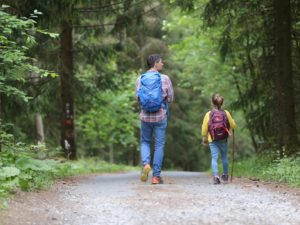As Pennsylvania continues to reopen, communities are even more eager to get outside and enjoy all that summer has to offer. Whether you’re hiking, planning a socially-distant BBQ, or just relaxing in the sun, Dr. Alan S. Peterson, MD explains the summer health hazards to be aware of.

As the former Director of Community and Environmental Medicine at Lancaster General Health, Dr. Peterson has been a valuable source of health information for the families across Lancaster County. Throughout the current pandemic, he has authored several articles in the Chronicle detailing the health risks to be aware of when spending time outdoors and how to protect yourself and your families…
“Hiking Amid Ticks”
According to the National Pest Management Association, climate changes have caused temperatures and precipitation to increase throughout the spring and summer months. Consequently, insect populations have proliferated across the United States, particularly in the Northeast, Great Lakes, South Central, and Northwest regions. With more conducive breeding environments for insects such as the tick, these communities are at higher risk of vector-borne infections such as Lyme disease.
With insect populations thriving through the summer, it is important to know the signs of infection. Symptoms of Lyme disease may include a rash that resembles a bull’s eye, chills, fatigue, head and muscle aches, neck stiffness, and joint pain. Pain or swelling in the knees has also been reported, primarily in young children. If you or someone you know is showing signs of Lyme disease, contact your doctor.
Even more important is how we can avoid Lyme disease. Prevention, Peterson explains, requires being “careful when walking in wooded or grassy areas.” If you’re hiking or even playing in your backyard, be sure to use bug spray with DEET repellant. When possible, wear long-sleeve shirts and long pants tucked into your socks. “I have had multiple patients develop Lyme disease just from mowing their lawn,” says Peterson.

“Bee’ Prepared”
In addition to Lyme disease, another insect to be wary of as we spend more of our time outdoors is the bee. Most individuals only feel temporary pain and swelling after a bee sting. However, for a small percentage of adults and children, bee stings are a cause for more serious concern. For these few, a bee sting can lead to a deadly allergic reaction called anaphylaxis. Further, multiple stings at one time or repeatedly throughout the same summer increase the risk of this response.
Symptoms of an anaphylactic reaction include itching and hives, swelling in the throat or tongue, difficulty breathing, and GI complications. If you have signs of a possible allergic reaction, seek medical attention right away. Following treatment, you can follow up with an allergist, who may prescribe you auto-injectable epinephrine (also known as an “epi-pen”) for more severe allergies.
“Sunburns on Busy Beaches”
The damage of a sunburn lasts long after those late August days by the water. Overexposure and unsafe exposure to the sun’s rays can cause early wrinkles and skin discoloration, accelerating the signs of aging. Of even greater concern, skin damage caused by UV rays can lead to skin cancers such as basal cell carcinoma and melanoma.
If you’re hesitant to use sunscreen, consider this: Our chances of developing melanoma, the most deadly form of skin cancer according to the Skin Cancer Foundation, are twice as high with “even one blistering sunburn in childhood or adolescence.” Recent research has shown that this risk increases by 80% if an individual suffers five or more serious sunburns before age 20. “The more you burn, the greater your risk,” states Dr. Peterson.
According to the American Academy of Dermatology, the best sunscreen to use offers broad-spectrum protection for both UVA and UVB rays, is SPF30 or higher, and water-resistant. The best practice is to use sunscreen every day before heading outdoors, even on cloudier days and regardless of where you live. Remember to seek shade whenever possible!
“Food Poisoning During a Pandemic”
According to the U.S. Department of Agriculture (USDA), foodborne illnesses are most prevalent during the summer months. One reason is that increased temperatures and higher humidity accelerate bacterial growth. Food safety is also more difficult when handling and preparing food outdoors for that socially-distant BBQ with friends.



The USDA offers four recommendations to lower the chances of food poisoning in the summer months amidst COVID-19:
(1) Wash your hands with soap and water for 20 seconds before, during, and after preparing food and before you eat. Clean utensils and equipment before and after use, and rinse foods before preparing whenever possible. This helps to eliminate the germs that spread foodborne illness.
(2) Separate raw meat, seafood, poultry, and eggs from other foods. Make sure to also separate kitchenware that has touched these raw items from other food products.
(3) Cook meats and poultry completely to kill any germs that cause foodborne illness. Using a food thermometer helps to ensure that food is safely cooked to the recommended internal temperature.
(4) Chill perishable foods in your refrigerator no more than 2 hours after preparation. If eating outdoors where temperatures are higher, consider refrigerating your perishables within one hour. You can thaw frozen food safely in the refrigerator, under warm water, or in the microwave. Avoid thawing frozen foods on countertops because bacteria aggressively multiply at room temperature.
“A Decrease in Water-Borne Diseases?”
Now, for some good news. The CDC has stated that there is “no evidence that the virus that causes COVID-19 can be spread to people through the water in pools, hot tubs, or water playgrounds.” Further, proper maintenance of these venues (i.e. chlorination) effectively kills the virus. It should be noted, however, that it takes more than just chlorine to effectively clean surfaces where transmission is more likely.
The issue with public swimming venues is the difficulty these locations pose to wearing a mask. Because wearing a mask can be uncomfortable and unsafe while swimming, proper social distancing is crucial in these locations to prevent airborne spread of the COVID-19 virus. The CDC explains that on a windy summer day at the pool or river, individuals should stay even farther apart than the recommended six feet. Interestingly, with so many aquatic venue closures, the rate of waterborne illnesses, such as the pervasive Cryptosporidium, have declined across the U.S.

